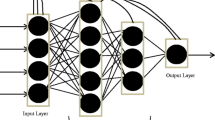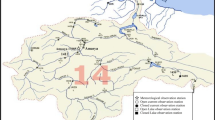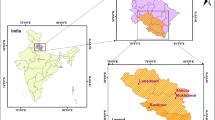Abstract
Prediction of daily evaporation has an important role in reservoir management, regional water planning and evaluation of drinking-water supplies. The main purpose of this study was to assess different types of mother wavelet as activation functions instead of commonly used sigmoid for finding the main differences in the results of daily pan evaporation prediction in the Lar synoptic station. So, using conjunction of wavelet theory and multilayer perceptron (MLP) network, two mother Wavelets named Mexican Hat and polyWOG1 are considered for developing hybrid WNNs. The algorithms were trained and tested using a 6-year data record (1999 daily values) from 2005/01/01 to 2010/09/01. Instead of using common sigmoid activation functions in MLP network, wavelet function was applied to construct the wavelet neural network. Results show that Mexican hat wavelet neural network in the best topology presents 98.35 % accuracy in training phase and 96.04 % in testing and PolyWOG1 wavelet neural network in the best topology presents 95.92 % accuracy in training phase and 91.03 % in testing of model. In the MLP model with standard sigmoid function results were 90.6 % in training and 87.63 % in testing. Comparison of WNN and MLP shows that Mexican hat mother wavelet could have better accuracy in the daily pan evaporation modeling.











Similar content being viewed by others
References
Abghari H, Nouri M, Rezaeian Zadeh M (2009) Reservoir dam inflow modeling using wavelet-base neural network and multilayer perceptron network. International Conference on Water Resources 1:665–670, (16–18 August 2009), Shahrood, Iran
Caudill M (1987) Neural networks primer, part I. AI Expert, December, 46–52
Chen Y, Yang B, Dong J (2006) Time Series Prediction using a local linear wavelet neural network. Neurocomputiong 69:449–465
Dawson CW, Wilby R (1998) An artificial neural network approach to rainfall-runoff modeling. Hydrolog Sci J 43(1):47–66
Dibik YB, Solomatine DP (2001) River flow forecasting using artificial neural networks. J Phys Chem Earth 26(1):1–7
Dulkashi S, Karunasinghe K, Shie-yui L (2006) Chaotic time series prediction with global model: artificial neural network. J Hydrol 323:92–105
Gaucherel C (2002) Use of wavelet transform for temporal characterization of remote watersheds. J Hydrol 269:101–121
Govindaraju RS, Rao AR (2000) Artificial neural networks in hydrology. Kluwer Academic Publisher, Netherlands
Haykin S (1994) Neural networks: a comprehensive foundation. Prentice Hall, New York
Hecht-Nielsen R (1990) Neurocomputing. Addison-Wesley Publishing Company, Reading
Hsu KL, Gupta HV, Sorooshian S (1995) Artificial neural network modeling of rainfall-runoff process. Water Resour Res 31(10):2517–2530
Jain A, Srinivasulu S (2006) Integrated approach to model decomposed flow hydrograph using artificial neural network and conceptual techniques. J Hydrol 317:291–306
Jawerth B, Sweldens W (1993) An overview of wavelet based multiresolution analysis. John Wily and Sons. New York Press
Kisi O (2004) River flow modeling using artificial neural networks. J Hydrolog Eng ASCE 9(1):60–63
Kisi O (2007) Streamflow forecasting using different artificial neural network algorithms. J Hydrolog Eng 12(5):532–539
Kisi O (2008) River flow forecasting and estimation using different artificial neural network techniques. J Hydrol Res 39(1):27–40
Kisi O (2009a) Wavelet regression model as an alternative to neural networks for monthly streamflow forecasting. Hydrolog Process 23(25):3583–3597
Kisi O (2009b) Neural networks and wavelet conjunction model for intermittent streamflow forecasting. ASCE J Hydrol Eng 14(8):773–782
Lekutai G (1997) Adaptive Self-Tuning Neuro Wavelet Network Controllers, Ph.D Dissertation in the Electrical Engineering Department. Virginia Polytechnic Institute and State University
Lotric U (2004) Wavelet base denoising integrated into MLP. Neurocomputing 62:179–196
Moghaddamnia A, Ghafari Gousheh M, Piri J, Amin S, Han D (2009) Evaporation estimation using artificial neural networks and adaptive neuro-fuzzy inference system techniques. Adv Water Resour 32(1):88–97
Murtagh F, Starck JL, Renaud O (2004) On neuro-wavelet modeling. Decision Support Systems 37:475–484
Oussar Y, Dreyfus G (2000) Initialization by selection for wavelet network training. Neurocomputing 34:131–143
Oussar Y, Rivals I, Personnaz L, Dreyfus G (1998) Training wavelet networks for nonlinear dynamic input-output modeling. Neurocomputing 20(1–3):173–188
Partal T, Kisi O (2007) Wavelet and Neuro-fuzzy conjunction model for precipitation forecasting. J Hydrol 342:199–212
Pati YC, Krishnaparasad PS (1993) Analysis and synthesis of feedforward neural networks using discrete affine wavelet transformations. IEEE Trans Neural Networks 4(1):73–85
Rezaeian Zadeh M, Tabari H (2012) MLP-based drought forecasting in different climatic regions. Theor Appl Climatol. doi:10.1007/s00704-012-0592-3
Rezaeian Zadeh MS, Amin D, Khalili V, Singh P (2010) Daily outflow prediction by multilayer perceptron with Logistic Sigmoid and Tangent Sigmoid activation functions. Water Resour Manage 24(11):2673–2688. doi:10.1007/s11269-009-9573-4
Rezaeian Zadeh M, Zand-Parsa Sh, Abghari H, Zolghadr M, Singh VP (2012a) Hourly air temperature driven using multi-layer perceptron and radial basis function networks in arid and semi-arid regions. Theor Appl Climatol. doi:10.1007/s00704-012-0595-0
Rezaeian Zadeh M, Tabari H, Abghari H (2012b) Prediction of monthly discharge volume by different artificial neural network algorithms in semi-arid regions. Arabian Journal of Geosciences. In press. doi: 10.1007/s12517-011-0517-y
Shamseldin AY (1997) Application of neural network technique to rainfall-runoff modeling. J Hydrol 199(3–4):272–294
Sudheer KP, Gosain AK, Ramasastri KS (2002) A data driven algorithm for constructing artificial neural network rainfall-runoff models. Hydrol Process 16(6):1325–1330
Tabari H, Marofi S, Sabziparvar AA (2010) Estimation of daily pan evaporation using artificial neural network and multivariate non-linear regression. Irrigat Sci 28:399–406
Tabari H, Hosseinzadeh Talaee P, Abghari H (2012) Utility of coactive neuro-fuzzy inference system for pan evaporation modeling in comparison with multilayer perceptron. Meteorol Atmos Phys. doi:10.1007/s00703-012-0184-x
Tao H (2006) Wavelet neural network model for forecasting exchange rate. Integrated with Genetic Algorithm. IJCSNS International Journal of Computer Science and Network Security, VOL.6 No.8A, 60-63. August 2006
Tokar AS, Johnson A (1999) Rainfall-runoff modeling using artificial neural networks. J Hydrolog Eng ASCE 4(3):232–239
Tokar AS, Markus M (2000) Precipitation-runoff modeling using artificial neural networks and conceptual models. J Hydrolog Eng ASCE 5(2):156–161
Wajdi B, Chokri BA, Alimi M (2006) Synthesis of Wavelet Filters using Wavelet Neural Networks. Transactions on Engineering, Computing and Technology, Vol 13 MAY. 108-111. ISSN 1305-5313
Wang W, Ding J (2003) Wavelet network model and its application to the prediction of hydrology. Nat Sci 1(1):67–71
Wang W, Van Gelder P, Vrijling JK (2006) Forecasting daily stream flow using hybrid ANN models. J Hydrol 324:383–399
Wicher, Percival, Guttorp (1996) Wavelet Analysis of Covariance with Application to Atmospheric Time Series, NRCSE-Technical Report, No: 024
Wu JS, Han J, Annambhotla S, Bryant S (2005) Artificial neural networks for forecasting watershed runoff and stream flows. J Hydrolog Eng ASCE 10(3):216–222
Zhang Q, Benveniste A (1992) Wavelet networks. IEEE Trans Neural Networks 3(6):889–898
Acknowledgments
The authors wish to thank the Islamic Republic of Iran Meteorological Organization (IRIMO) for providing the requisite meteorological data. The authors express their gratitude to the Urmia University for their supports. Special thanks are due to the useful comments and suggestions of editor and two anonymous reviewers.
Author information
Authors and Affiliations
Corresponding author
Rights and permissions
About this article
Cite this article
Abghari, H., Ahmadi, H., Besharat, S. et al. Prediction of Daily Pan Evaporation using Wavelet Neural Networks. Water Resour Manage 26, 3639–3652 (2012). https://doi.org/10.1007/s11269-012-0096-z
Received:
Accepted:
Published:
Issue Date:
DOI: https://doi.org/10.1007/s11269-012-0096-z




